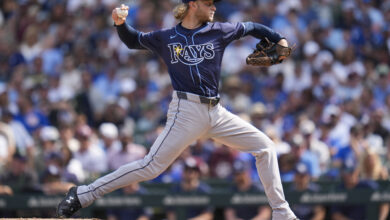
Lance Lynn Would Be Decent Option if Cubs Miss on ‘Big Three’
The Cubs’ offseason search for a pitcher to fill the void in their rotation has been well-documented, with potential targets Yu Darvish, Alex Cobb, and Jake Arrieta sharing top billing. We have heard numerous reports connecting these three pitchers to the Cubs, but what if there was a alternative solution to save some money and still put forth a top-notch starting five? I’m speaking of Lance Lynn, the former Cardinals righty.
While Lynn has been connected to the Cubs by little more than whispers in all the rumors and reports we’ve gotten over the last several weeks, there’s a possibility he could effectively fill the void. Now, I’m going against Evan’s thoughts on the matter by saying this, but who doesn’t like a little debate?
Prior to the news that they’d re-signed lefty reliever Brian Deunsing, the Cubs figured to have plenty of flexibility at around $30 million below the luxury tax. They’re still roughly $27 million below the limit with Duensing, which means the reported asks of Arrieta and Darvish wouldn’t necessarily put them over. Meanwhile, Cobb is rumored to be seeking at least $17.5 million AAV over four years.
Lynn, projected for a four-year, $68 million deal by SB Nation’s Grant Brisbee and five-year, $75 million deal by Jim Bowden, could be slightly cheaper. Now, I suspect we’ll see a decrease in the AAV for each of the aforementioned pitchers, and anything below the $20 million range would afford the Cubs more money to allocate toward other needs, such as a veteran backup catcher or other position-player depth.
This discussion is pointless if the market falls low enough to meet the Cubs’ rumored three-year, $42 million offer to Cobb, but we’ll assume for the purposes of this post that that won’t happen.
For this article, I’m going to focus on Arrieta, Cobb, and Lynn and what each bring to the table. Arrieta is the oldest of the bunch as he turns 32 in March, followed by Lynn (31 in May) and Cobb (31 in October). All three had comparable ERAs last season with Lynn (3.43) having the slight advantage over Arrieta (3.53) and Cobb (3.66). Comparing each player’s FIP paints a whole different story, though, as Arrieta and Cobb had identical 4.16 FIPs while Lynn’s 4.82 lagged well behind.
There is definitely some room for regression for Lynn, who averaged 1.07 fewer K/9 than his career average and struggled with his control, issuing a career-high 3.77 BB/9 and 1.3 HR/9. He could be given the benefit of the doubt for some of those issues due to missing the entire 2016 season following Tommy John surgery, but time will tell. Based on these metrics and the idea that pitchers don’t usually get better at his age, signing Lynn seems to have the greatest amount of risk.
Another area to consider is the significant advantage Cobb had in GB/FB ratio (0.98) in 2017 compared to Arrieta and Lynn, who both had a 0.84 ratio. With Chicago’s dazzling young infielders, pitchers who induce ground balls are set up to succeed (case in point: Kyle Hendricks). Added to the higher home run totals, you could be looking at John Lackey, Pt. II.
But in spite of all the risks Lynn’s performance presents, one area in which he has excelled throughout his career is his dependability. He has made at least 31 starts and has pitched more than 175 innings in each of his five full seasons. That includes last season, in which Lynn (33, 186.1) led Arrieta (30, 168.1) and Cobb (29, 179.1) in games started and innings pitched.
Cobb has not shown that he is capable of repeating that workload to this point in his career and he’s coming off of a TJ surgery of his own. Arrieta’s crossfire delivery and inconsistent mechanics don’t necessarily bode well for his future, either. No one can guarantee a pitcher’s health over time, but there’s a great deal of value in having a guy who can take the bump every fifth day.
Because Lynn and Cobb have similar risk profiles and potential costs, that ability to make starts and eat innings could be attractive. Over their last four full seasons, Lynn has averaged 191.2 IP compared to Cobb’s 156.1 IP. As good as the Cubs’ bullpen looks, those extra 35 innings may actually prove that Lynn isn’t as risky as the metrics indicate.
Fortunately, the Cubs are in a position to have a say in the market for each of these starting pitchers and seem poised to land one of them. Darvish (we didn’t look at him much here, but I assume you’re aware of him) and Arrieta offer ace-level production, but at a high cost and less payroll flexibility moving forward. Cobb and Arrieta offer familiarity, which also has it perks. If the Cubs are looking for more value, Lynn and Cobb fit that criteria.
With Hendricks, Jon Lester, and Jose Quintana already anchoring the top of the rotation and Tyler Chatwood as an upgrade over John Lackey, there’s a need for a pitcher to slide into the last spot in the rotation. Lynn is a more economical option, but are the savings really worth the risk when compared to other options such as Cobb? Eh, maybe not. Lynn should probably rate below the other three pitchers on the Cubs’ priority list, but that doesn’t mean that he would be a bad addition to the rotation.
So in the event that something goes really sideways in the market and the Cubs end up missing out on the three targets to whom they’ve been tied, all is not lost. And it might actually end up working out pretty well.

